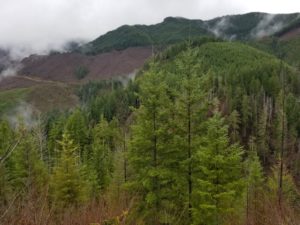Do you remember learning in school about deciduous trees and evergreen or conifer trees? The big distinguishing difference is that deciduous trees lose their leaves in the winter and evergreen or conifer trees keep their green “leaves” or needles all winter.

Image: Notice the aspens leaves are changing and the spruce trees remain green.
Even though conifer trees don’t lose their needles in the winter the tree needs a way to shed out the old growth. They do that with an annual shed about the same time as deciduous trees lose their leaves in the fall. Think of it like animals, they shed their summer coat before growing their winter coat and vise versa in the spring. The trees are getting rid of the old to prepare for dormancy in the winter and save energy for new growth that will occur in the spring. When you hike out in the woods you will notice needles on the ground around the spruce, fir and pine trees, and that is another indicator that this is a natural event with conifer trees.

Image: Notice how there is excessive needle loss. This is different than the normal seasonal needle shed.
This shed is often confused with the tree dying or being diseased, but rest assured most of the time this is a natural process. If you are concerned about your conifer trees needles turning yellow or brown take a closer look and see if it is just the internal needles that are turning or if all the needles are turning. If it is just a few internal needles on the branches then it is most likely the tree shedding. If all the needles are turning brown there may be another underlying issue.

Image: Normal seasonal needle shed
If you do still have questions about your evergreen trees needles turning yellow or brown feel free to give us a call and send us a picture of the tree and we will give you an assessment to see if there is something more going on with your trees. Happy Fall!

